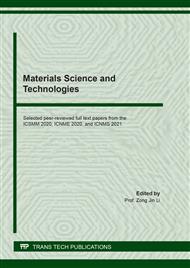p.77
p.83
p.89
p.99
p.105
p.111
p.116
p.125
p.131
Performance Testing of NaCMC/HPC/NaAlg Hydrogels for Agricultural Applications
Abstract:
Physically cross-linked NaCMC/HPC/NaAlg hydrogel beads were subjected to several performance tests to determine their ability to mitigate the immediate impacts of drought and their effectiveness to control nutrient release in soil. The tests showed that the beads have a water absorption capacity of 2438%, indicating superabsorbent capability. Reusability tests showed that they are capable of at least six cycles of swelling/deswelling with a net decrease in swelling from 331% to 170%. Nutrient release studies were done using a multistage diffusion model to examine their effectiveness in controlled release. Soil amendment studies showed that a 2.65% increase in the maximum water holding capacity is obtained per 0.1% of hydrogels in soil. Furthermore, phytotoxicity studies showed that the germination indices of representative vegetable crops planted in hydrogel-treated soil are above well above the threshold for phytotoxicity limit. Lastly, the hydrogels also showed potential as a growing substrate in soilless cultivation.
Info:
Periodical:
Pages:
105-110
Citation:
Online since:
July 2021
Keywords:
Price:
Сopyright:
© 2021 Trans Tech Publications Ltd. All Rights Reserved
Share:
Citation:


